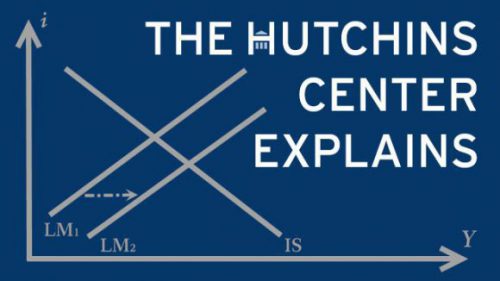The European Central Bank, unable to push short-term interest rates any lower, is on the verge of launching a major round of large-scale asset purchases (LSAP), also known as “quantitative easing” (QE).
So now would be a good time to review economic analyses of how this monetary maneuver worked in the U.S., the U.K. and Japan. This question remains the subject of active research. After all, Ben Bernanke, in his final weeks as Fed chairman, quipped here at Brookings that quantitative easing works in practice, not in theory.
Economists generally find QE lowered long-term interest rates in the U.S., though estimates of the magnitude of such effects vary. Study of the U.K. and Japan comes to similar conclusions. There is disagreement on the mechanisms through which bond buying affects financial markets, on the extent to which purchases of government debt influence prices of other assets, such as houses, and on the macroeconomic effects all of this.
Here is a brief primer on the economic evidence on the effectiveness of QE so far:
When does a central bank resort to QE?
Central banks traditionally conduct monetary policy by lowering short-term interest rates when the economy is weak and raising rates when the economy is strong. In December 2008, the Fed pushed its policy rate to zero (known as the zero lower bound), but inflation was still too low and the economic recovery was weak. The Fed then turned to quantitative easing to provide more monetary stimulus and lower long-term rates. Abroad, the Bank of England and Bank of Japan also turned to quantitative easing policies when they reached the zero lower bound in late 2008 or early 2009.
See “A Citizen’s Guide to Unconventional Monetary Policy,” by Renee Haltom and Alexander L. Wolman (2012) for more background.
How does QE work?
Quantitative easing refers to large-scale asset purchases conducted by a central bank in order to put downward pressure on market interest rates. Quantitative easing works through two channels. The first is the portfolio rebalance channel, whereby the central bank changes the relative supply of assets available to investors. As investors replace government bonds they sell to the Fed with other, riskier assets, the prices of those assets—stocks or houses, for instance—tend to rise, helping to stimulate business and consumer spending. The second way QE helps to lower market interest rates is by signaling that the central bank plans to keep policy rates low for a long time. There is evidence that both the portfolio rebalancing and signaling channels were at play in the United States. Eventually, rising asset prices and falling mortgage rates helped to stimulate the broader economy through the same channels as conventional monetary policy. In the U.K., Japan and Europe, QE—or the prospect of QE—also contributed to a weakening of the currency, making exports more attractive.
See former Fed Chairman Ben Bernanke’s 2012 speech on “Monetary Policy since the Onset of the Crisis” for more information.
How have central banks conducted QE?
Not all quantitative easing programs have the same effects; the scale and scope of the programs matter. Generally, the term “quantitative easing” describes any policy that increases the central bank’s liabilities—currency and bank reserves. The Bank of Japan in the early 2000s and the Bank of England in 2008 undertook QE to expand the total amount of bank reserves, hoping to encourage more bank lending. Former Fed Chair Ben Bernanke referred to such a policy as “pure QE.” In contrast, in the United States, the Fed did three rounds of quantitative easing, with asset purchases targeted at specific markets. Bernanke called that “credit easing,” but the label didn’t stick. In QE1, announced in November 2008, the Fed purchased $1.75 trillion of long-term Treasuries, mortgage-backed securities guaranteed by Fannie Mae and Freddie Mac, and debt of Fannie and Freddie. These asset purchases targeted long-term rates, specifically mortgage rates. In QE2, announced in November 2010, the Fed purchased an additional $600 billion in long-term Treasuries to target long-term rates generally. In September 2012, the Fed announced open-ended monthly purchases of $85 billion in agency-backed mortgage backed securities and treasuries known as QE3, and tied these asset purchases to the state of the labor market. These purchases came to an end in October last year.
For more information on how QE was conducted in the United States and internationally, see the following papers:
“A Citizen’s Guide to Unconventional Monetary Policy.” Renee Haltom and Alexander L. Wolman. 2012
“Four Stories of Quantitative Easing.” Brett W. Fawley and Christopher J. Neely. 2013.
Did it work?
In a paper written for the Hutchins Center early in 2014, John C. Williams, president of the Federal Reserve Bank of San Francisco, summarized the research on quantitative easing: “although individual estimates differ, this analysis consistently finds that asset purchases have sizable effects on yields on longer-term securities,” but “there remains a great deal of uncertainty about the magnitude of these effects and their impact on the overall economy.” The economic research, he said, suggested that each $600 billion of bond purchases by the Fed lowered long-term interest rates by between 0.15 and 0.25 percentage points. In 2012, Bernanke remarked that the Fed’s “first two rounds of LSAPs [large-scale asset purchases] may have raised the level of output by almost 3 percent and increased private payroll employment by more than 2 million jobs, relative to what otherwise would have occurred.” Researchers at the Bank of England also found that the first £200 billion in QE purchases lowered yields on UK government securities by about 100 basis points, and may have increased inflation by 1.5% and real GDP by 2%.
Concerns that QE would create hyperinflation have proven to be misplaced. However, critics assert that the effects of QE have not really been felt beyond financial markets, citing the absence of a strong economic recovery, and others argue that QE in fact exacerbates income inequality because the rich tend to benefit disproportionately from higher asset prices.
For more information on the effectiveness of QE, see
“The Financial Market Effects of the Federal Reserve’s Large-Scale Asset Purchases,” by Joseph Gagnon, Matthew Raskin, Julie Remache, and Brian Sack, 2011.
“The Effects of Quantitative Easg on Interest Rates: Channels and Implications for Policy,” by Arvind Krishnamurthy and Annette Vissing-Jorgensen, 2011.
“The Financial Market Impact of Quantitative Easing in the United Kingdom,” by Michael A. S. Joyce, Ana Lasaosa, Ibrahim Stevens, and Matthew Tong, 2011.
“Monetary Policy at the Zero Lower Bound: Putting Theory into Practice,” President John C. Williams of the San Francisco Fed, 2014.
The Brookings Institution is committed to quality, independence, and impact.
We are supported by a diverse array of funders. In line with our values and policies, each Brookings publication represents the sole views of its author(s).



Commentary
The Hutchins Center Explains: Quantitative Easing
January 21, 2015